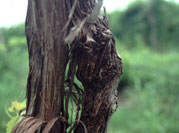Trunk Cold Injury
If more than 50 percent of the primary buds are killed by cold winter temperatures, then cane and trunk damage is likely. This is difficult to assess in the dormant season. After growth starts, a small section of bark can be cut out with a knife in order to observe the phloem and cambium tissue underneath. Healthy tissue is nearly white or green. Tissue that has suffered some damage is gray to light brown and severely damaged tissue is almost black. One symptom of trunk injury is sap exudation in droplets in March or April. Later in the season as weather warms, longitudinal splits may occur when injured phloem tissue is unable to control surface evaporation. Winter injured trunks may develop crown gall on the injured sections.
When growing winter tender varieties, 3 to 6 trunks of different ages can be maintained. In the first year, the new shoot is tied to the wire and in the second year, it is trained to the height of the old trunk. The oldest or most damaged trunk is removed when the renewal trunk is 2 to 3 years old. Another method for protection of tender vines is to lay the vine down in the row and cover it with friable soil, straw, or other insulating material.

Crown gall on the right trunk of a double trunked grapevine. Photo courtesy of Patrick Byers, Missouri State State Fruit Experiment Station